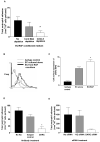Duffy antigen receptor for chemokines and CXCL5 are essential for the recruitment of neutrophils in a multicellular model of rheumatoid arthritis synovium
- PMID: 18576313
- PMCID: PMC2821686
- DOI: 10.1002/art.23545
Duffy antigen receptor for chemokines and CXCL5 are essential for the recruitment of neutrophils in a multicellular model of rheumatoid arthritis synovium
Abstract
Objective: The role of chemokines and their transporters in rheumatoid arthritis (RA) is poorly described. Evidence suggests that CXCL5 plays an important role, because it is abundant in RA tissue, and its neutralization moderates joint damage in animal models of arthritis. Expression of the chemokine transporter Duffy antigen receptor for chemokines (DARC) is also up-regulated in early RA. The aim of this study was to investigate the role of CXCL5 and DARC in regulating neutrophil recruitment, using an in vitro model of RA synovium.
Methods: To model RA synovium, RA synovial fibroblasts (RASFs) were cocultured with endothelial cells (ECs) for 24 hours. Gene expression in cocultured cells was investigated using TaqMan gene arrays. The roles of CXCL5 and DARC were determined by incorporating cocultures into a flow-based adhesion assay, in which their function was demonstrated by blocking neutrophil recruitment with neutralizing reagents.
Results: EC-RASF coculture induced chemokine expression in both cell types. Although the expression of CXC chemokines was modestly up-regulated in ECs, the expression of CXCL1, CXCL5, and CXCL8 was greatly increased in RASFs. RASFs also promoted the recruitment of flowing neutrophils to ECs. Anti-CXCL5 antibody abolished neutrophil recruitment by neutralizing CXCL5 expressed on ECs or when used to immunodeplete coculture-conditioned medium. DARC was also induced on ECs by coculture, and anti-Fy6 antibody or small interfering RNA targeting of DARC expression effectively abolished neutrophil recruitment.
Conclusion: This study is the first to demonstrate, in a model of human disease, that the function of DARC is essential for editing the chemokine signals presented by ECs and for promoting unwanted leukocyte recruitment.
Figures


Similar articles
-
A novel mechanism of neutrophil recruitment in a coculture model of the rheumatoid synovium.Arthritis Rheum. 2005 Nov;52(11):3460-9. doi: 10.1002/art.21394. Arthritis Rheum. 2005. PMID: 16255036 Free PMC article.
-
An initial investigation into endothelial CC chemokine expression in the human rheumatoid synovium.Cytokine. 2017 Sep;97:133-140. doi: 10.1016/j.cyto.2017.05.023. Cytokine. 2017. PMID: 28648867 Free PMC article.
-
CXCR2-specific chemokines mediate leukotriene B4-dependent recruitment of neutrophils to inflamed joints in mice with antigen-induced arthritis.Arthritis Rheum. 2008 Jul;58(7):2030-40. doi: 10.1002/art.23597. Arthritis Rheum. 2008. PMID: 18576322
-
The Duffy antigen receptor for chemokines: structural analysis and expression in the brain.J Leukoc Biol. 1996 Jan;59(1):29-38. doi: 10.1002/jlb.59.1.29. J Leukoc Biol. 1996. PMID: 8558064 Review.
-
Contribution of Duffy antigen to chemokine function.Cytokine Growth Factor Rev. 2005 Dec;16(6):687-94. doi: 10.1016/j.cytogfr.2005.05.011. Epub 2005 Jul 27. Cytokine Growth Factor Rev. 2005. PMID: 16054417 Review.
Cited by
-
The Duffy antigen receptor for chemokines transports chemokines and supports their promigratory activity.Nat Immunol. 2009 Jan;10(1):101-8. doi: 10.1038/ni.1675. Epub 2008 Dec 7. Nat Immunol. 2009. PMID: 19060902 Free PMC article.
-
CXCL5 mediates UVB irradiation-induced pain.Sci Transl Med. 2011 Jul 6;3(90):90ra60. doi: 10.1126/scitranslmed.3002193. Sci Transl Med. 2011. PMID: 21734176 Free PMC article.
-
Podocytes regulate neutrophil recruitment by glomerular endothelial cells via IL-6-mediated crosstalk.J Immunol. 2014 Jul 1;193(1):234-43. doi: 10.4049/jimmunol.1300229. Epub 2014 May 28. J Immunol. 2014. PMID: 24872191 Free PMC article. Clinical Trial.
-
Candidate SNP Markers of Gender-Biased Autoimmune Complications of Monogenic Diseases Are Predicted by a Significant Change in the Affinity of TATA-Binding Protein for Human Gene Promoters.Front Immunol. 2016 Apr 4;7:130. doi: 10.3389/fimmu.2016.00130. eCollection 2016. Front Immunol. 2016. PMID: 27092142 Free PMC article.
-
3'-Sialyllactose as an inhibitor of p65 phosphorylation ameliorates the progression of experimental rheumatoid arthritis.Br J Pharmacol. 2018 Dec;175(23):4295-4309. doi: 10.1111/bph.14486. Epub 2018 Oct 17. Br J Pharmacol. 2018. PMID: 30152858 Free PMC article.
References
-
- Springer TA. Traffic signals on endothelium for lymphocyte recirculation and leukocyte emigration. Ann. Rev. Physiol. 1995;57:827–72. - PubMed
-
- Imhof BA, Dunon D. Leukocyte migration and adhesion. Adv. Immunol. 1995;58:345–416. - PubMed
-
- Halloran MM, Woods JM, Strieter RM, Szekanecz Z, Volin MV, Hosaka S, et al. The Role of an Epithelial Neutrophil-Activating Peptide-78-Like Protein in Rat Adjuvant-Induced Arthritis. J Immunol. 1999;162:7492–500. - PubMed
-
- Gardner L, Patterson AM, Ashton BA, Stone MA, Middleton J. The human Duffy antigen binds selected inflammatory but not homeostatic chemokines. Biochem. Biophys. Res. Commun. 2004;321:306–12. - PubMed
Publication types
MeSH terms
Substances
Grants and funding
LinkOut - more resources
Full Text Sources
Other Literature Sources
Medical

